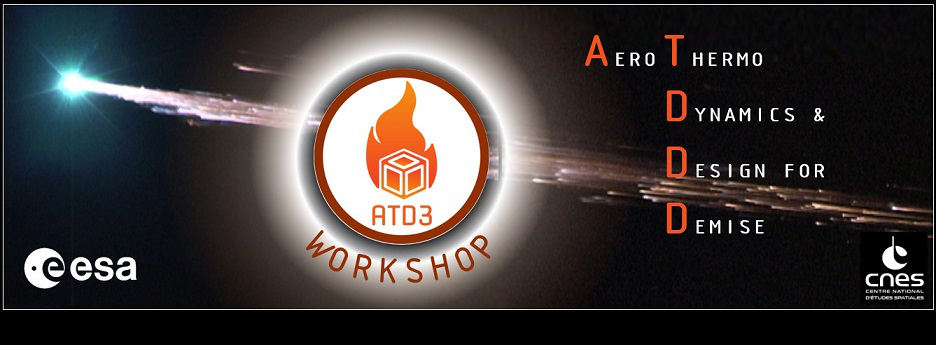A spectroscopy test campaign was conducted to observe the emission from the shock layer of a blunted model in an impulsive facility HEK-X[1] in the JAXA Kakuda space center. The HEK-X is a free-piston-driven expansion tube developed for fundamental studies of super-orbital aerothermodynamics, which was designed to produce shock speed up to 14km/s. Applying 'tuned operation,' the facility can...
Several D4D techniques are available to achieve a complete spacecraft (equipment) demise. The mass can be minimized or more demisable materials can be selected, the heat flux could be controlled by altering the ballistic coefficient and local geometry of objects or an early fragmentation of the spacecraft and its equipment could be facilitated. If some fragments survive, their impact on the...
These 10 last years, the prediction of the space debris survivability during their re-entry and the associated prospective risk on ground are more and more in the scope of scientific researches.
The 2nd of November 2016, two objects were found in South India: a COPV tank near Dindigul and a titanium tank near Karur. They are fragments from ESA’s AVUM upper stage used on the first...
Carbon Fibers Reinforced Polymers (CFRP) are used in the manufacturing of pressurized tanks for satellites or launcher upper stages. These composite materials, usually wrapped around a metallic liner, show a strong resistance to demisability when exposed to high enthalpy flows since they fundamentally behave similarly to ablative Thermal Protection Materials (TPMs). The objective of the...
The goal of the ongoing GSTP “Validation of Space Debris Demise Tools using Plasma Wind Tunnel Testing and Numerical Tools” between VKI (prime) and Cenaero is the execution of detailed high-enthalpy demisability experiments in the VKI Plasmatron to support the development of high-fidelity numerical models, from which improved engineering correlations may be eventually derived.
During the...
To properly account for non-equilibrium in high enthalpy flows, state-to-state (StS) kinetics should be the most reliable, describing internal distributions departing from the Boltzmann. Due to the large dimension of the chemical system, this model requires computational time not affordable on nowadays computers, and most of the applications were limited to 1D geometries [1-3]. In recent...
Pressure Vessels have gained notoriety for being one of the most frequently identified spacecraft debris items recovered on ground following destructive entry events. As such, they constitute a key factor in determining the overall ground risk associated with a given uncontrolled entry event.
Due to their often straightforward physical features as uniformly blunt bodies, spherical pressure...
Reducing the risk of casualties from debris uncontrolled re-entry is of major interest. It requires to advance the knowledge of space debris degradation during their re-entry and to strengthen the predictive capabilities of the high-fidelity and spacecraft-oriented numerical tools and material response solvers.
Under the present study, various materials have been identified to be analysed and...
Recent data has shown that between 2000 and 2020, the number of objects in orbit around the Earth has increased by approximately 82%, reaching a value close to 20000 objects, from which 53% are fragmentation debris, and the current tendency is for the number of space objects to grow in the forthcoming years. This increase has led to the need for a sustainable use of the space environment, by...
R.Tech is active since 20 years in the field of numerical simulation for aerothermodynamic reentry and is working with the CNES on the problematic of space debris since 10 years. An overview of different tools developed is presented. The combination of high fidelity codes Mistral-CFD in the continuum regime and Mistral-DSMC in the rarefied regime allow to simulate any conditions for a LEO...
The French Space Agency CNES in collaboration with R.Tech have developed a probabilistic tool to evaluate the survivability of space debris based on DEBRISK. The uncertainties of all the models are accounted for. Their effect on the survivability is quantified through Monte Carlo method to evaluate its distribution compared with the determinist approach. Two models for simulating the...
This project addresses aerothermodynamics tools for Design for Demise (D4D) and aims to create a step-change in safer spacecraft development by improving the speed, accuracy, and usability of aerothermal D4D tools. Any new tool developed must not only be sufficiently accurate and generate results at an appropriate rate and cost, but most also be intuitive to use.
The current project,...
Our compagnie is involved in composite for 41 years.
We have studied possibility to create demisable pressure vessels for re-entry application.
The proposed pressure vessel uses thermoplastic liner and composite outer shell.
We have selected a composite made of epoxy and fibres for the outer shell.
The peculiar fiber extremely light and strong. its key advantage is that it melts at 130°C.
In the years between 1995 and 2015, dedicated research activities were conducted at the Department of Industrial Engineering of the University of Naples Federico II with the ultimate goal of building a Database of aerodynamic coefficients (CD and CL) for simple-shape bodies (such as spheres, cylinders, cones) in different aerodynamic conditions (special focus on hypersonic low-density regime)....
In NASA’s Object Reentry Survival Analysis Tool (ORSAT), aerodynamic drag and aerothermal heating coefficients are computed for each of the free-molecular, continuum, and transitional flow regimes using analytical and semi-analytical methods. These methods are typically limited to convex, blunt objects (such as spheres) and are applied to other objects such as boxes and cylinders using...

